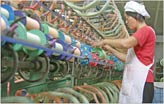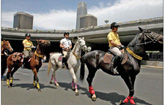Editorials
Sustainable growth plan
Updated: 2011-06-13 08:54
(China Daily)
If transformation of the development mode, one of the major goals of the country's 12th Five-Year Plan (2011-2015), provides, in general terms, what can be expected of development in the coming five years, the management of the country's territory according to areas with different functions represents a concrete step the State Council is taking toward that.
The country will be divided into four functional types of areas, according to the plan unveiled by the State Council on Wednesday. They are optimized development areas, key development areas, areas for specialized development and areas where industrial development is prohibited.
Different yardsticks will be used to assess the performance of the different areas. For example, for the optimized development areas, economic structure, consumption of resources, environmental protection and innovation in science and technology will be the most important factors. While the degree of industrialization and the level of urbanization will be the major factors assessed for the performance of key development areas.
Areas for specialized development are further divided into two types: those for agricultural production and those for ecological development. For the former, mixed agricultural production capacity rather than the economic growth rate will be the decisive factor in judging their performance. For the latter, it will be the degree of ecological protection and the capacity to provide ecological products. For areas where industrial development is prohibited, how well the natural or cultural resources are protected will be the criterion.
The policies involving finance, investment, industries, use of land, population, ethnic groups, environmental protection and climate change will be differentiated for the different areas.
Obviously, such a mechanism is meant to change the current situation whereby gross domestic product (GDP) is worshipped as the sole development goal for all localities. For instance, industrial projects and urbanization will be strictly prohibited in nature reserves in the new management mode.
Given the increasingly sharp contradiction between economic growth and the deteriorating environment, as well as the rapid depletion of resources, such a mechanism is long overdue.
China can no longer afford to seek growth without considering the cost to the environment, the depletion of resources and the development potential for future generations.
Despite efforts to reduce energy intensity per unit output of GDP, it is still much higher than developed countries. So is the consumption of resources for every 10,000 yuan ($1,543) of GDP. More than 70 percent of the country's rivers are polluted to different degrees and the lack of water has become a bottleneck for further development of most cities.
If implemented well, the plan is a significant contribution to the country's sustainable development.
Given local protectionism and local government leaders' enthusiasm for economic growth, rebalancing the interests of different localities with different development functions will be key to the success of the plan.
(China Daily 06/13/2011 page8)
Specials

Wealth of difference
Rich coastal areas offer contrasting ways of dealing with country's development

Seal of approval
The dying tradition of seal engraving has now become a UNIVERSITY major

Making perfect horse sense
Riding horses to work may be the clean, green answer to frustrated car owners in traffic-trapped cities